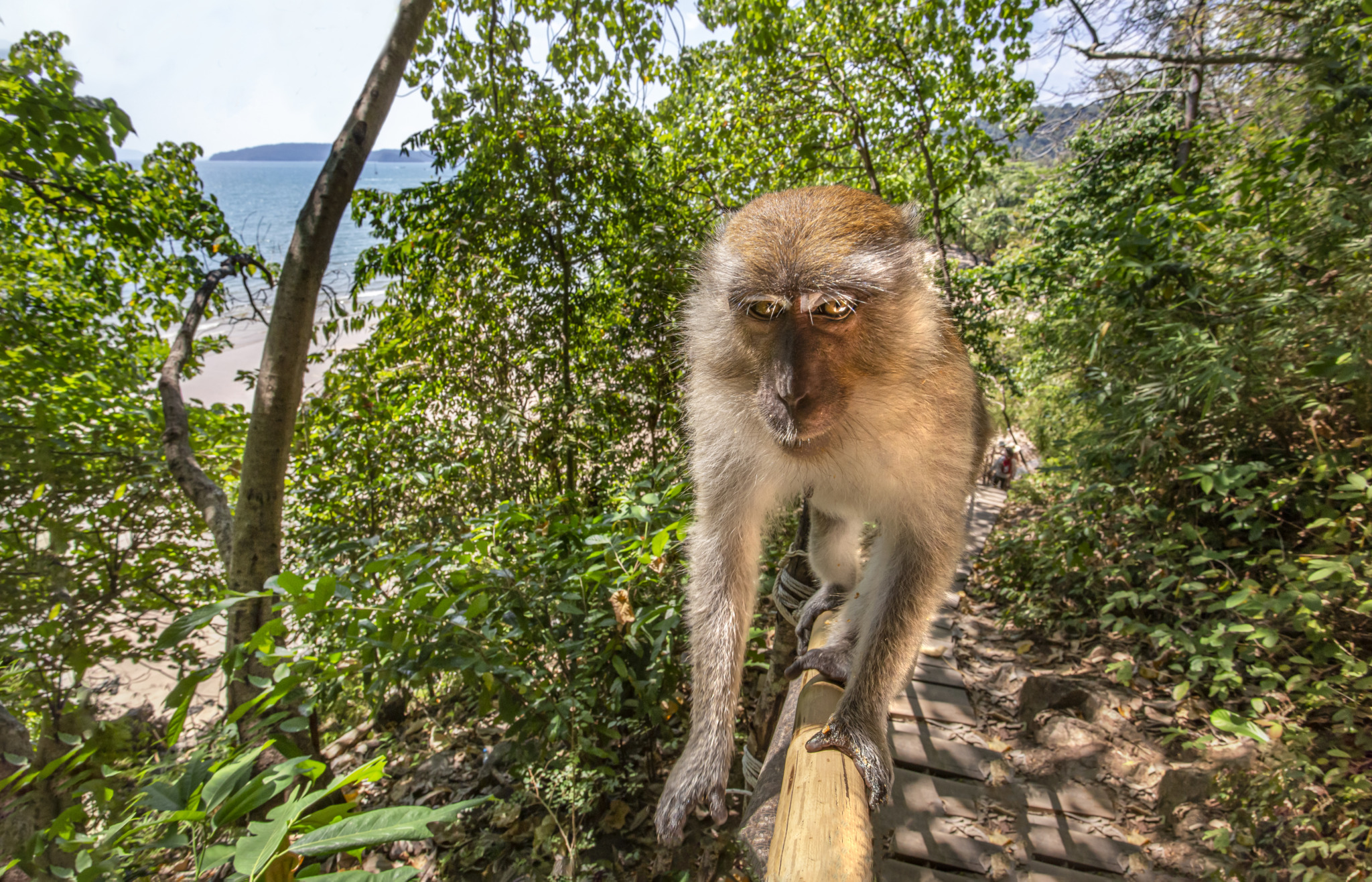That’s an excellent choice. The Crab-eating Macaque (Macaca fascicularis), also commonly known as the Long-tailed Macaque, is one of the most widespread and adaptable primate species in Southeast Asia.
Here is a deep review of its key characteristics, biology, and ecological and social significance.
🐒 Crab-eating Macaque (Macaca fascicularis) Deep Review
1. Morphology and Identification
The Crab-eating Macaque is a medium-sized monkey with a distinctive tail and color patterns.
| Feature | Detail |
| Size & Weight | Head-Body Length: 40–47 cm (16–18.5 in). Tail Length: Long and non-prehensile, often longer than the body (up to 50–60 cm). Weight: Males (5–9 kg) are significantly larger than females (3–4 kg). |
| Coloration | Generally brownish or grayish, with a slightly lighter underside. The fur on the head often forms a distinct crest or cap that sweeps back to a point. |
| Facial Features | Their faces are flat, often with cheek whiskers or mutton-chops. Males often develop prominent canines and have redder skin patches on their face or chest when excited. |
| Key Name: | The common name “Crab-eating” is a misnomer, as crabs constitute only a small part of its overall diet. “Long-tailed Macaque” is the more accurate descriptive common name. |
| Life Span | Can live up to 30 years in captivity, though significantly less in the wild. |
2. Habitat and Distribution
- Geographic Range: One of the most widespread non-human primates in Asia, ranging from Bangladesh and Myanmar across Southeast Asia, including Thailand, Vietnam, Cambodia, Laos, Malaysia, Indonesia (Sumatra, Java, Borneo), and the Philippines.
- Habitat Adaptability: Highly successful because of its extreme adaptability, the species occupies an incredibly diverse range of environments:
- Primary Habitat: Mangrove forests, coastal areas, and riparian (riverbank) forests—hence the “crab-eating” name, as it forages extensively along the water’s edge.
- Secondary Habitats: Lowland forests, swamp forests, secondary growth areas, and heavily human-impacted areas (farmland, parks, urban temples). This tolerance is a major factor in its population success.
- Semi-Terrestrial: While they are excellent climbers (arboreal) and spend much time in trees, they are frequently seen foraging on the ground (terrestrial).
3. Diet and Foraging
The Crab-eating Macaque is an opportunistic omnivore with a highly varied diet.
- Main Diet: Primarily frugivorous (fruit-eaters). Its diet also includes a large proportion of insects, leaves, flowers, seeds, and fungi.
- Coastal/Aquatic Diet: Along the coasts and rivers, it forages for crabs, mollusks, frogs, shrimp, and fish. They are known to exhibit sophisticated behaviors to access food, such as using rocks to smash shells or dipping food in water to clean it.
- Human Subsidy: In areas with high human traffic (like temples or tourist areas), they rely heavily on food provided by tourists or raid crops and garbage. This dependence often leads to conflict.
4. Social Structure and Behavior
Macaques are highly social primates that live in complex, hierarchical groups.
- Group Structure: They live in multi-male, multi-female groups called troops, which can range in size from 5 to over 50 individuals.
- Matrilineal Hierarchy: Females form the core of the troop’s hierarchy; rank is inherited from the mother and is highly stable. Daughters usually stay in the natal group for life (matrilocal).
- Male Dispersal: Males leave their birth troop around the age of 4–6 and must integrate into a new troop, usually occupying a lower rank initially. Male hierarchy is more fluid and often based on strength, aggression, and alliances.
- Aggression: Aggression, often associated with maintaining dominance ranks, is common. It usually manifests through visual threats, chases, and sometimes fighting.
- Communication: They communicate using a wide range of vocalizations (grunts, squeals, screams) and facial expressions (lip smacking, staring, yawning).
- Tool Use: They are one of the few primates known to regularly use simple tools in the wild. This includes using stones to break open shellfish and nuts, and using hairs or sticks as dental floss.
5. Conservation Status and Human Conflict
- Conservation Status: Currently listed as Vulnerable (VU) by the IUCN. While locally abundant in many areas, the species is facing pressure across its wide range.
- Threats:
- Habitat Loss: Deforestation and the draining of mangrove areas destroy its natural habitat.
- Pet Trade/Bushmeat: Significant illegal trade and hunting occur in parts of its range.
- Biomedical Research: They are one of the most widely used primates in scientific and pharmaceutical testing, leading to large-scale collection from the wild.
- Human Conflict: Due to their adaptability and willingness to live near people, macaques are frequently viewed as pests when they raid crops, steal food from homes, and show aggression toward tourists. Management of these conflicts is a critical conservation challenge.
Visited 851 times, 6 visit(s) today
Views: 1441
Subscribe to the newsletter:
